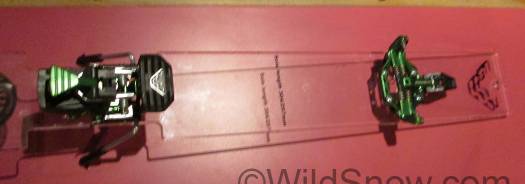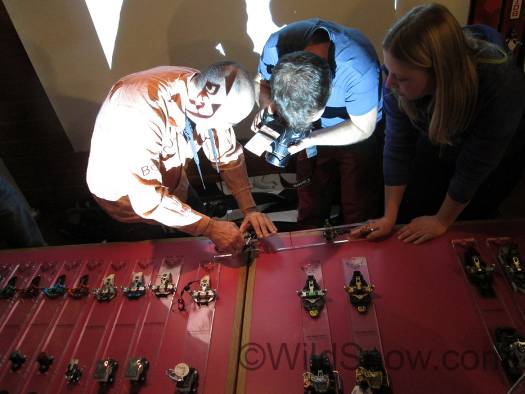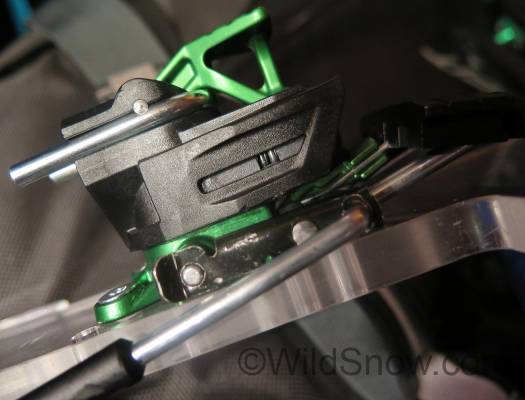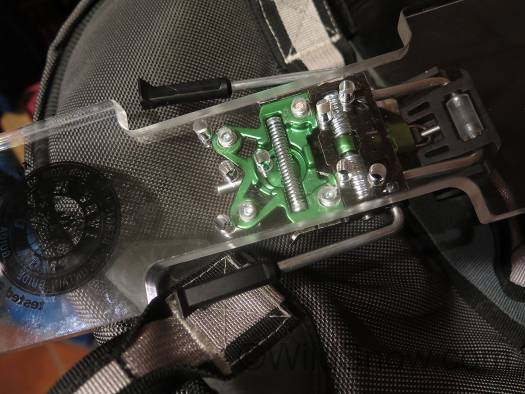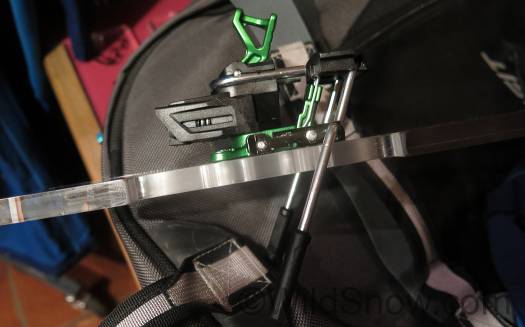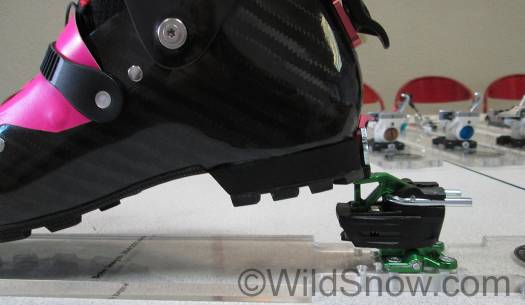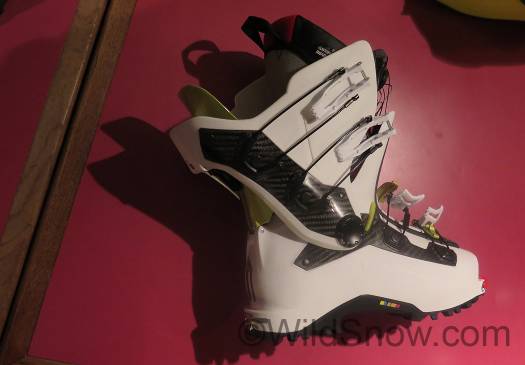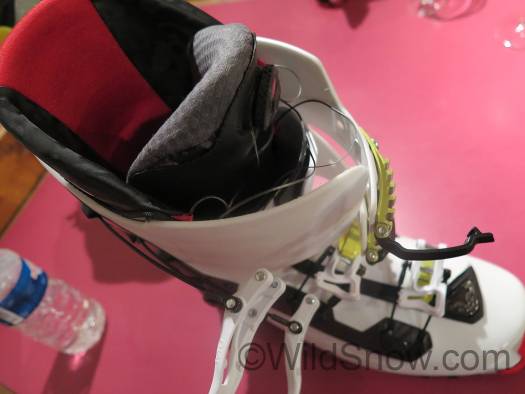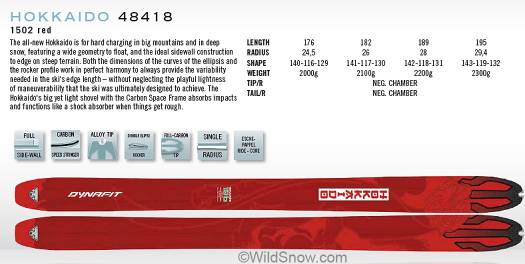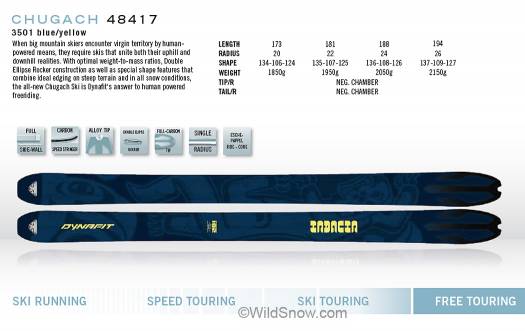I’ve seen the future and it is the past. Dynafit TLT Superlight 2.0 is the big news for ski touring. Yeah, this binding has existed in various incarnations for years, but guess what? Hearkening back decades ago, Dynafit has cooked up a removable brake that appears in initial bench evaluation (warning, Koolaid consumed) to be the ultimate A1 sweet spot for ski touring when weight is key. 175 grams with the brake adding a bit more, but you can pop the brake on and off in seconds. The binding uses the old “U spring” vertical release system that engineers have told me they “wished would just go away,” but persists because it allows building a light simple “beautiful” binding. Women’s version lateral release sets from 5-10 RV , men’s 7-12. You can swap the U springs to change vertical release, men’s in the box is 9, women’s is 7. But the big news with this is the swap brake. Only in 80 mm for now, but the modders will take care of that problem in mere seconds.
We’re at the annual Dynafit press event, this time being held in Beaufort, France. A quick summary now, more meat later. Dynafit’s new products for 2015-2016 are strong in the freeride “free touring” category, and the racing side is getting attention as well. The Khion boot is an entirely new model that may fit nicely in the 4-buckle lightweight-but-stiff arena that few boots can survive. Claim is the new shoe “combines the rigidity and support of an alpine downhill boot with the comfort and lightness of a modern ski touring boot.” Yeah, you’ve heard that before, and these days that dream does sometimes become reality. Will Khion deliver the dream? It does look good.
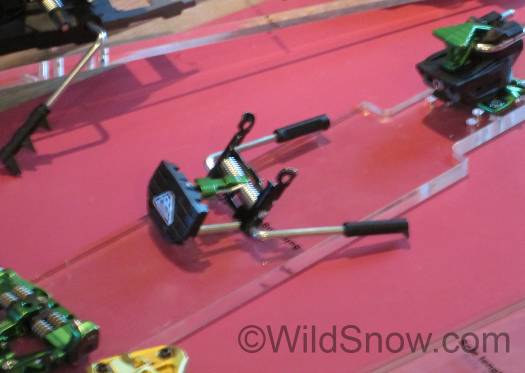
TLT Speed Superlight with removable brake. So cool it is beyond even my highly developed ability to express myself in writing. Here at press event, you should have seen the photographers hovering around this thing, it looked like Angelina J. had just showed up with her latest look. Hilarious to see the powers-that-be in backcountry skiing journalism virtually ignoring the latest engineering and fawning over 20-year-old technology. But 20? That was a very good age.
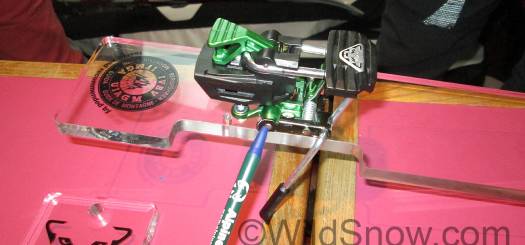
Removing brake is nearly tool-free. You just push in the button and slide it off. Installing requires no tools.
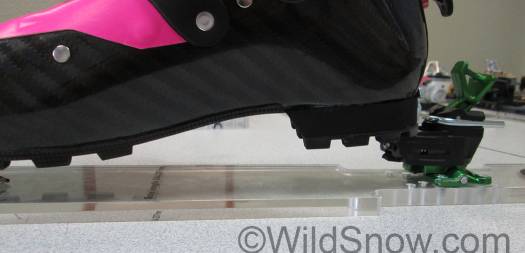
This is the lowest the heel will ‘officially’ go on the Angelina 2.0, but you can rotate the heel unit to the side for a totally heel-flat-on-ski mode. I could see shimming front of binding up 3 millimeters, in that case the boot would be quite flat at the lowest heel position. Officially the binding has only two heel lift positions.
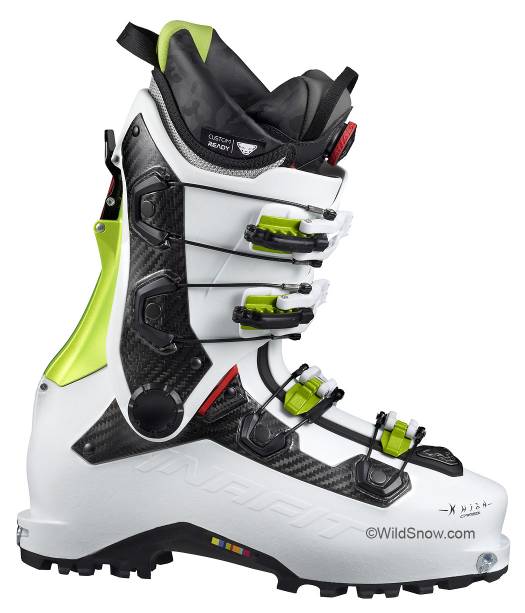
Khion Carbon will be top of the line, a combo freeride boot that tours like a Reudi and skis like a Cody. This version could be too stiff, MS version is made without the carbon and has a more forgiving flex. (Click images to enlarge).
Dynafit will also ramp up their ski mountaineering race sponsorship and product lines. They’ve hired former Italian National Team head coach Oscar Angeloni to lead their race division, and they’ve got some wild new colorways for the race boots, clothing and skis.
Also on the binding front, Dynafit will be placing new emphasis on supplying their certified boot inserts, and communicating that their bindings are only guaranteed to function correctly with the OEM inserts. In our view this continues to be a positive process for the tech binding industry, as the boot fittings are as much a part of a tech binding as the machinery bolted to your skis. This is only a step, however, as ultimately the boot fittings should be standardized “officially” and anyone who has the wherewithal to make them in compliance with the standard should be able to do so.
Along the same line, Dynafit says they’ll be making a concerted push to make the now “virtual” tech binding standard into an “official” standard that’ll probably be promulgated by ISO. We assume this mostly means the boot fittings, but will probably involve dimensions and shapes of binding parts, and more.
I’ll add some opinion about “official standards.” As I’ve attempted to clarify and detail the “DIN/ISO” certifications from TUV that ski binding marketing folks are bragging on, I’ve come to learn how irrelevant or downright unsuitable for tech (pintech) bindings the existing standards can be. I’ve also learned the TUV process is super expensive, and as I’ve suspected, insiders tell me that when companies do go for TUV certification to the binding standards it’s possible they’ll actually have to change excellent real-life features to less than ideal configurations that will pass the mostly artificial lab tests that TUV does.
Result: folks from three different tech binding companies have told me they’ll either “not bother with TUV,” or “only attempt TUV certification of a few bindings.” On our end, my pledge is to watch how much I tout the TUV certifications and perhaps an apology from me is even due, for what might have been too exuberant of a take on how important TUV is to you guys, the actual users of the bindings. The more important aspects of a tech binding are 1) How it skis in real life with attention to skiing unlocked without pre-release, 2) How durable, re consumer testing, 3)how it behaves on the workbench and carpet in “safety” release checks, 4)awareness that “classic” tech bindings most certainly do not have the performance of modern alpine bindings in terms of protection from lower leg fractures, as well as elasticity/retention.
How all the above factors influence us in real life will hopefully be studied some day. As I’ve said before, I’m not seeing an epidemic of leg injuries suffered by tech binding users. But both blown knees and broken legs are not unheard of.
Also regarding bindings, a real zinger here was the announcement that Dynafit will be licensing Fischer, Look (Rossignol & Dynastar) and Movement to brand Dynafit OEM bindings under their own company monikers. I’m not sure what benefit this will have for consumers. In fact, on the surface it appears it could be detrimental as there are most often multiple versions of the same Dynafit binding model, with associated “in line” improvements. Faced with multiple binding choices under different brands, consumers will have to suss out what is what, which is already hard enough when all the bindings carry the Dynafit logo. What is more, Dynafit claims they’ll be careful about how these bindings are priced — but as the years and seasons progress, where re-branded gear really ends up being sold and for what prices is always a question, and may cause a confusion for shoppers.
Back to the Khion boot. The holy grail of ski boots for aggressive riders is the alpine boot that tours. While boots of this nature are not our go-to in the WildSnow touring-for-turns environment, we certainly see the need for them. Vulcan has been Dynafit’s answer to that, and it proved worthy. Khion is a complete departure. Still stiff, but lighter, lower volume, and with a carefully integrated liner-shell-buckle system that’s said to make the boot ride stronger and smoother than ever. That’s the Koolaid, anyhow. The boots do look beautiful.
But what is a new boot without being paired with new skis? Freeride again. The new Dynafit Chugach is a “100 waist” plank that comes in with a 107mm middle, 22 meter radius, and 1,950 grams per 181 cm length. That’s reasonable weight, and we’d suspect strong performance. Dynafit says the ski has “double ellipse rocker construction” that helps it hold on steep hard snow while still performing in the soft. That will require some translation and verification. If you want something wider still, Dynafit’s Hokkaido might not be fat enough for its namesake but it comes in fairly rotund at 135/114/125, weight/surface will probably be similar to Chugach. Note these new freeride skis are more along the alpine vein in terms of their weight, as they’re intended for heavy and somewhat violent days of bliss.
In all honesty, there are so many skis out there now with good dimensions and reasonable weight, we’ll want to do extensive evaluation with numerous skiers before we sing praises. For now I can say we’re looking forward to the process.
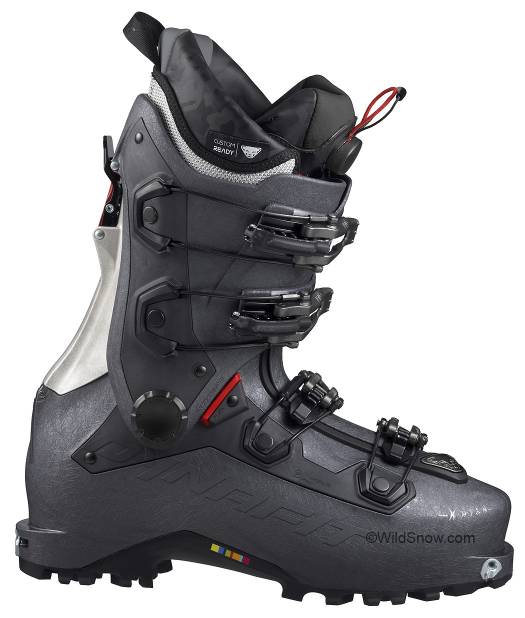
Khion MS, is the non carbon version with a more forgiving flex, for a bit less coin it still competes in the 4-buckle combo freeride boot category.
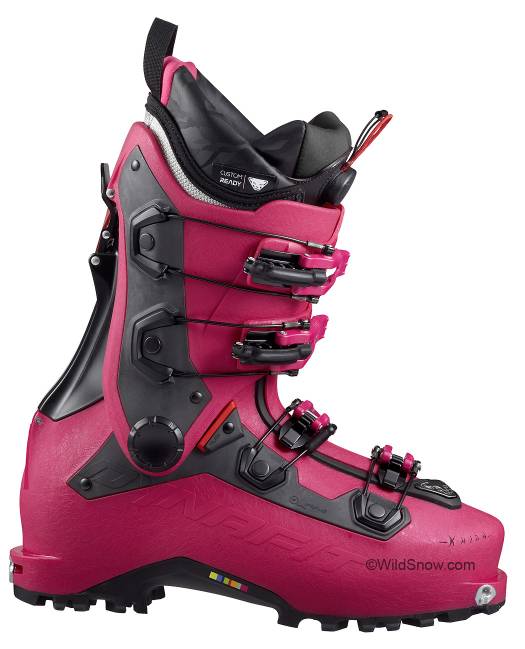
Khion WS women’s version. Pretty much the same boot with a bit different fit in the cuff area. Is the color a hit or a miss? In any case, pretty bold!
Almost like an Angelina sighting, the Radical 2.0 was spied among his security detail. (Perhaps he and Angelina are dating?) Radical 2.0 is said to have been delayed in production by a manufacturing detail in the brake system. We think it was probably the catch that locks the brake up during touring mode — always a challenge for any tech binding manufacturer. Images below show the parts in question.
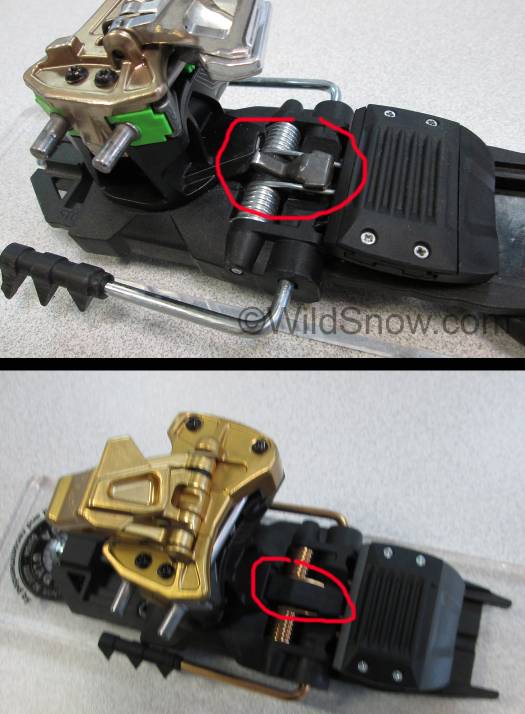
Radical 2.0 brake catch. Upper photo shows the catch, which appears difficult to get into the right shape and size. Photo below shows how it’s covered with a plastic shell in retail version. Looks nice and in bench testing it works fine.
Dynafit PR copy excerpt edit, regarding Radical 2.0 which as delayed for 2015-16 retail and is looking good:
Radical 2 model will be unveiled at retail for the 2015-16 winter season. It combines safety with comfort and performance at a weight of 599 grams. The biggest update is the patented pivoting toe piece combined with the Step in Side Towers. One, this functions as an additional release mechanism; two, it works to prevent early release from side impacts. The release value of the ski touring version (Radical 2 ST) is 4 to 10. The Radical FT goes up to 12. In order to guarantee the best performance and power transmission, the extra wide Railsystem was developed (Wildsnow: meaning the base of the binding is wider). With 10mm of forward pressure (Wildsnow, what they actually mean is that the heel unit has 10 mm of movement fore/aft on a track), it promises good performance during downhill. The Railsystem provides 45mm in boot length length adjustment for the largest range in a (WildSnow: non demo non rental) tech binding. In addition, the Radical 2 has an optimally low stack height for optimal boot-to-ski contact. 4 stoppers (brakes) from 90mm to 135mm.
Dynafit PR copy excerpt:
The Khiôn is a highly technical, modern free touring boot… The goal was unrivaled performance and precision with direct power transmission and maximal support…thanks to the new Precision Lock System. This patented system enables the various parts of the boot to work together as a torsional stiff unit and thus allows maximum rigidity even under higher mechanical loads. The rigidity of the Magnesium Spoiler used here also saves weight, allowing the Precision Lock System to develop its full power. Lateral stability and stiffness in the forward lean is achieved via the “exoskeleton” in the exterior shell. Lateral dampers and asymmetrical construction support the legs when carving turns and ensure direct power transmission. Its surface was specially designed to reduce frictional resistance in the snow. This saves energy on the ascent and diminishes the risk of catching rocks or branches. The patented buckle system can be completely open with one quick hand motion without the need to alter current settings…
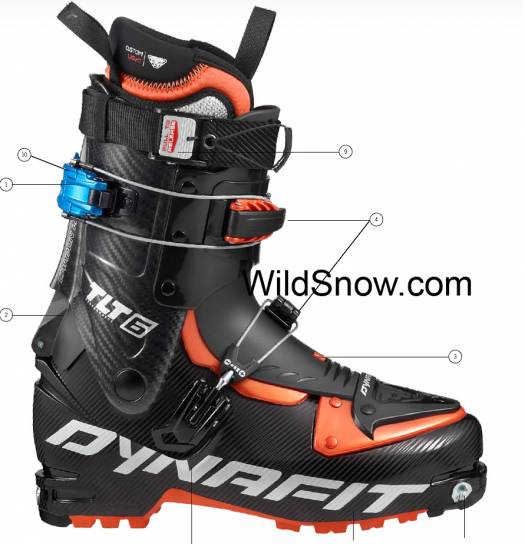
TLT6-P for 2015-2016 sheds the eye burning colors, adds gigantic logo. We like the colors, could do without the logo. This is pretty much the same boot as last year. Small improvements and changes are being marketed as ‘2.0’ such as buckles that are said to work better. Biggest change is probably a slightly relaxed last in the forefoot area that could make the boot warmer and easier to fit. Change to the quick release power strap is appreciated.
In closing, I’m going to sneak in a total 100% rumor. I’m predicting that within a year Dynafit will announce a branded airbag backpack that utilizes their style of making lightweight rucksacks. The plumbing will be from a pre-existing airbag pack maker, I won’t mention any names at this point. But really, shouldn’t Dynafit be the ones selling the lightest airbag pack? I was surprised to not see one here at the press event.
bye bye
WildSnow.com publisher emeritus and founder Lou (Louis Dawson) has a 50+ years career in climbing, backcountry skiing and ski mountaineering. He was the first person in history to ski down all 54 Colorado 14,000-foot peaks, has authored numerous books about about backcountry skiing, and has skied from the summit of Denali in Alaska, North America’s highest mountain.

